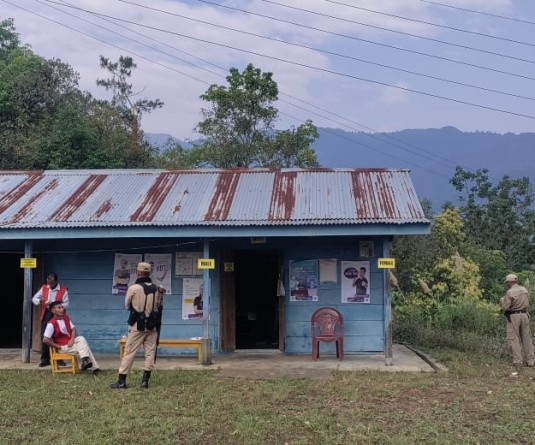
Dimapur, July 23 (MExN): The Government of Nagaland officially proposes autonomy for the regions demanded by an organization representing the eastern areas of Nagaland. The state Cabinet has proposed to the Centre the formation for an autonomous council or authority for four eastern districts of Nagaland, in response to the demand of the Eastern Nagaland Peoples’ Organization (ENPO) to cede as a separate state from Nagaland.
The Cabinet Secretariat of Nagaland issued a statement today outlining the government’s contentions on an issue of the ENPO seeking separation of the eastern regions from the state. Cabinet Secretary Lalthara appended the Cabinet memo. The Nagaland Cabinet noted a resolution on July 20, 2011 passed during a joint meeting of the Democratic Alliance of Nagaland government legislators and Members of Parliament. The resolution had decided to recommend to the state Cabinet for the creation of an autonomous council of the “ENPO areas” to the government of India for consideration. The “ENPO areas” are Tuensang, Mon, Longleng and Kiphire districts.
The government stated – “The Cabinet therefore proposes the formation of an autonomous council or authority comprising the four eastern districts of Nagaland in view of certain historical background as reflected in the provisions of Article 371-A (2) of the Constitution of India, and the area being comparatively less developed, provided that it is the desire of the people to be expressed in a democratic manner through their constitutionally elected representatives as well as other popularly accepted public organizations or platforms.”
The Cabinet is convinced that the Government of India knows “what should be the best way of resolving the issue at hand keeping in view the larger interest of the Naga people.”
The Cabinet therefore, the government said, has decided to request the government of India to intervene in the matter by ‘taking an early decision so further problems do not arise in Nagaland already faced with multiple problems.’
The Cabinet said that the state government had already constituted a high-level official committee headed by the chief secretary to study the demand, as well as other points. The committee had submitted its findings and recommendations to the State government on May 23, 2011 and that the Cabinet had considered the committee’s report.
The state had then constituted five Cabinet sub-committees to “pursue the findings and recommendations” in the report f the high-level official committee. “These committees have already started their works in all seriousness with a view to find solutions for redressing the genuine grievances and the special problems which were highlighted in the ENPO memorandum as well as the high-level official committee report,” the Cabinet stated.
The ENPO had demanded a separate called “frontier Nagaland” carved out of the state, as stated in a memorandum on November 25, 2010 submitted to the Prime Minister of India and referred back to the Government of Nagaland for its views on the matter, by the Government of India.
The Cabinet Secretariat of Nagaland issued a statement today outlining the government’s contentions on an issue of the ENPO seeking separation of the eastern regions from the state. Cabinet Secretary Lalthara appended the Cabinet memo. The Nagaland Cabinet noted a resolution on July 20, 2011 passed during a joint meeting of the Democratic Alliance of Nagaland government legislators and Members of Parliament. The resolution had decided to recommend to the state Cabinet for the creation of an autonomous council of the “ENPO areas” to the government of India for consideration. The “ENPO areas” are Tuensang, Mon, Longleng and Kiphire districts.
The government stated – “The Cabinet therefore proposes the formation of an autonomous council or authority comprising the four eastern districts of Nagaland in view of certain historical background as reflected in the provisions of Article 371-A (2) of the Constitution of India, and the area being comparatively less developed, provided that it is the desire of the people to be expressed in a democratic manner through their constitutionally elected representatives as well as other popularly accepted public organizations or platforms.”
The Cabinet is convinced that the Government of India knows “what should be the best way of resolving the issue at hand keeping in view the larger interest of the Naga people.”
The Cabinet therefore, the government said, has decided to request the government of India to intervene in the matter by ‘taking an early decision so further problems do not arise in Nagaland already faced with multiple problems.’
The Cabinet said that the state government had already constituted a high-level official committee headed by the chief secretary to study the demand, as well as other points. The committee had submitted its findings and recommendations to the State government on May 23, 2011 and that the Cabinet had considered the committee’s report.
The state had then constituted five Cabinet sub-committees to “pursue the findings and recommendations” in the report f the high-level official committee. “These committees have already started their works in all seriousness with a view to find solutions for redressing the genuine grievances and the special problems which were highlighted in the ENPO memorandum as well as the high-level official committee report,” the Cabinet stated.
The ENPO had demanded a separate called “frontier Nagaland” carved out of the state, as stated in a memorandum on November 25, 2010 submitted to the Prime Minister of India and referred back to the Government of Nagaland for its views on the matter, by the Government of India.




